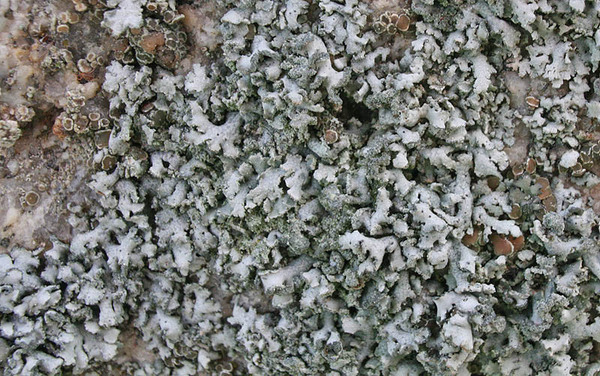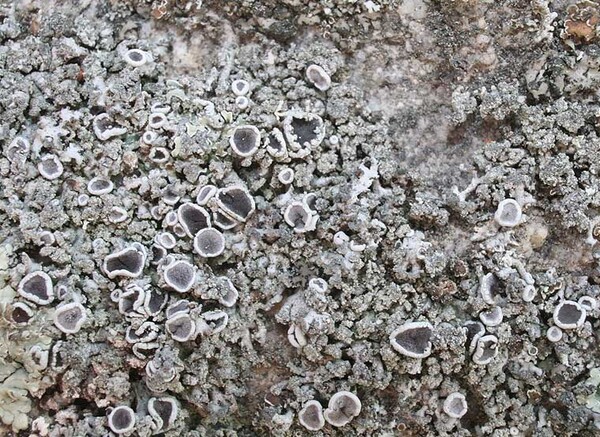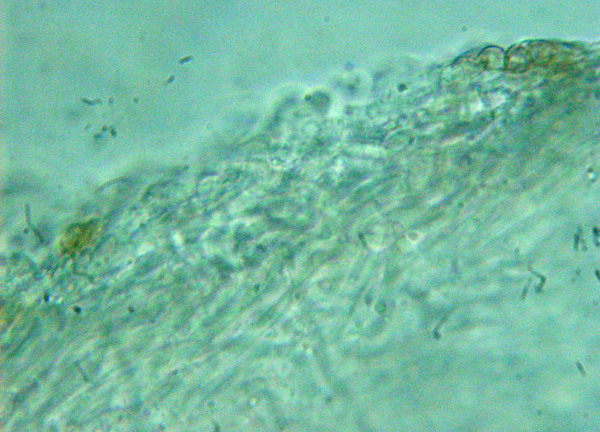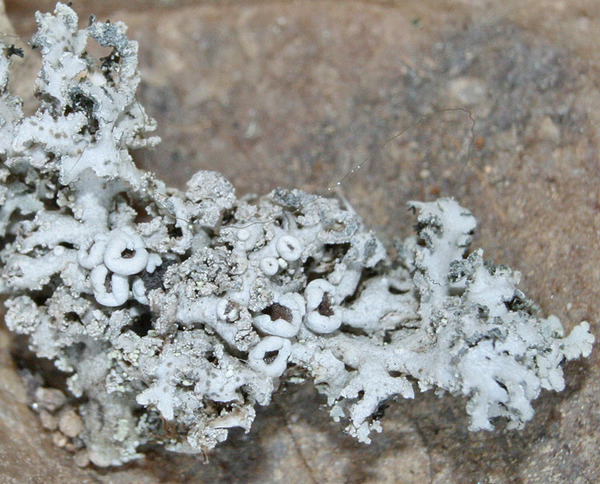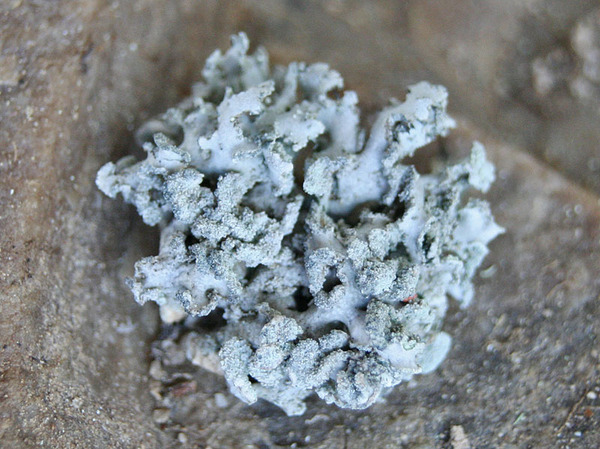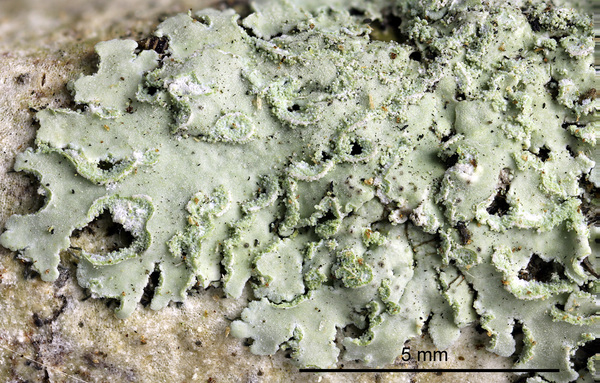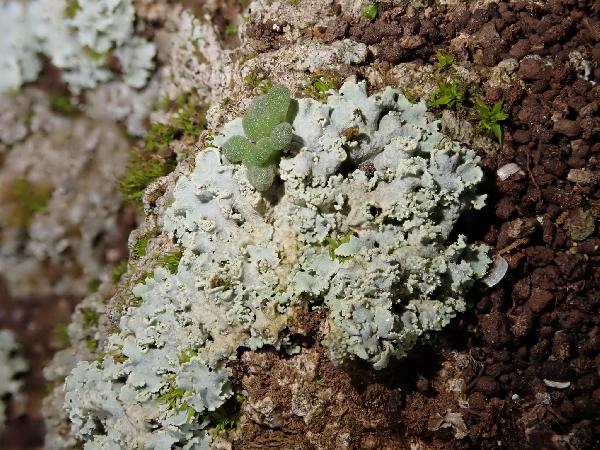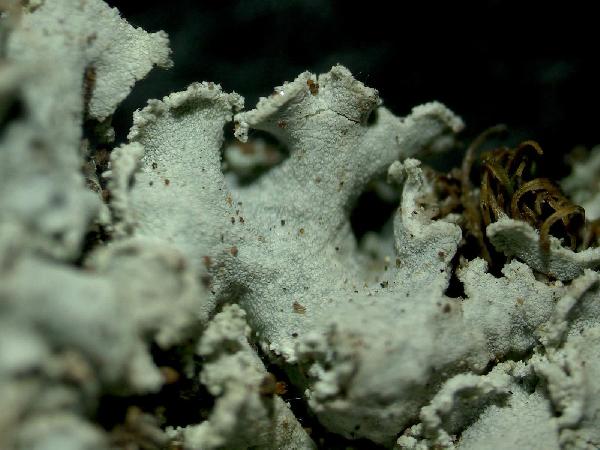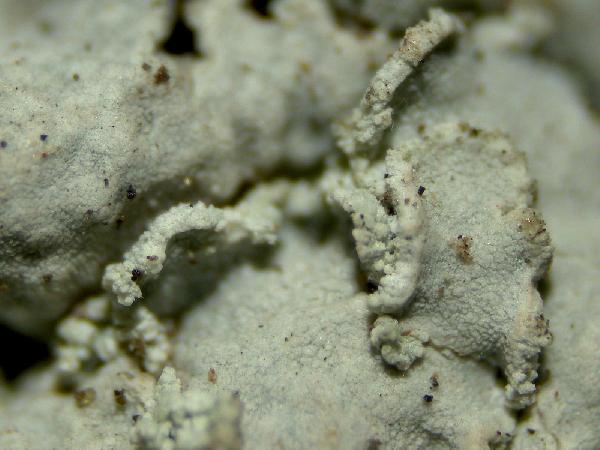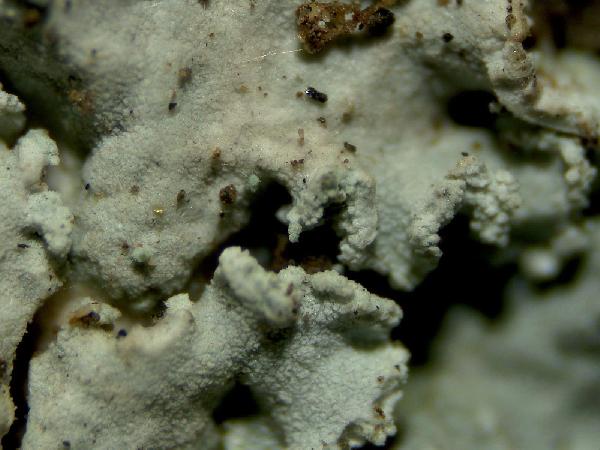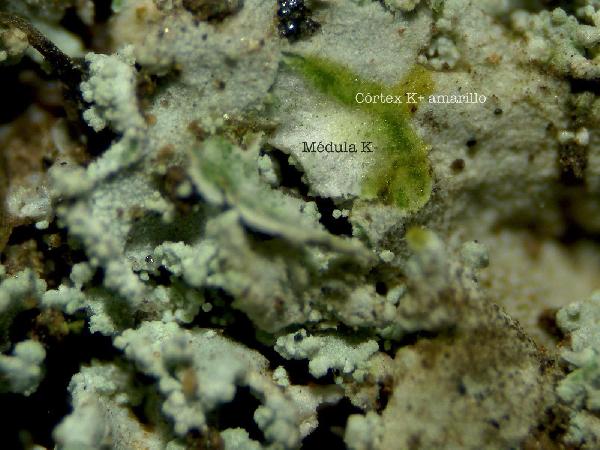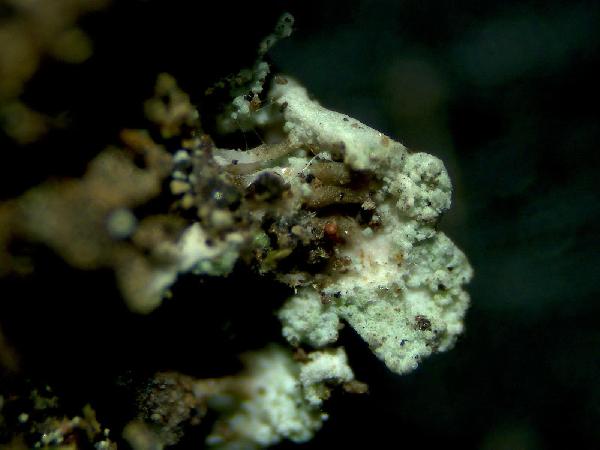Physcia dimidiata (Arnold) Nyl.
Flora, 64: 573, 1881. Basionym: Parmelia pulverulenta var. dimidiata Arnold - Flora, 47: 594, 1864.
Synonyms: Parmelia albinea var. dimidiata (Arnold) Jatta; Physcia dimidiata var. ornata (Nádv.) Moberg?
Description: Thallus foliose, heteromerous, dorsiventral, narrow-lobed, forming irregular to rarely orbicular, up to 2(-3) cm wide rosettes, several thalli sometimes merging to cover larger surfaces. Lobes overlapping, usually 0.5-1.2(-1.5) mm wide, rarely wider, eroded-crenulate and minutely lobulate at tips, the upper surface brownish grey to cream-coloured, emaculate, markedly and densely pruinose, with granular soredia arranged in elongated, marginal soralia which, in old specimens, may extend to the central parts; lower surface whitish to brownish, with pale, mostly simple rhizines. Upper cortex paraplectenchymatous; medulla white; lower cortex indistinctly prosoplectenchymatous. Apothecia very rare, lecanorine, up to 2 mm across, with a white-pruinose disc and an often sorediate thalline margin. Epithecium brown; hymenium and hypothecium colourless; paraphyses slender, simple or forked in upper part, the apical cells clavate, with a thin, dark brown cap. Asci 8-spored, clavate, the K/I+ blue tholus penetrated by a faintly amyloid apical cushion with parallel or diverging flanks, the wall K/I-, surrounded by a K/I+ blue outer layer, Lecanora-type. Ascospores 1-septate, brown, ellipsoid, 17-23 x 8-12 µm, the wall thickened at apex and at septum, Physcia-type. Photobiont chlorococcoid. Spot tests: upper cortex K+ yellow, C-, KC-, P- or P+ faintly yellow; medulla K-, C-, KC-, P-. Chemistry: upper cortex with atranorin.
Growth form: Foliose, narrow lobed
Photobiont: green algae other than Trentepohlia
Reproductive strategy: mainly asexual, by soredia, or soredia-like structures (e.g. blastidia)
On otherwise dry surfaces with short periods of water seepage after rain
Commonnes-rarity: (info)
Alpine belt: absent
Subalpine belt: absent
Montane belt: absent
Dry submediterranean belt: very rare
Humid submediterranean belt: rare
Padanian area: absent
pH of the substrata:
1 2 3 4 5
Solar irradiation:
1 2 3 4 5
Aridity:
1 2 3 4 5
Eutrophication:
1 2 3 4 5
Poleotolerance:
0 1 2 3
Altitudinal distribution:
1 2 3 4 5 6
Rarity
absent
extremely rare
very rare
rare
rather rare
rather common
common
very common
extremely common
Loading data...
Occurrence data
Predictive map
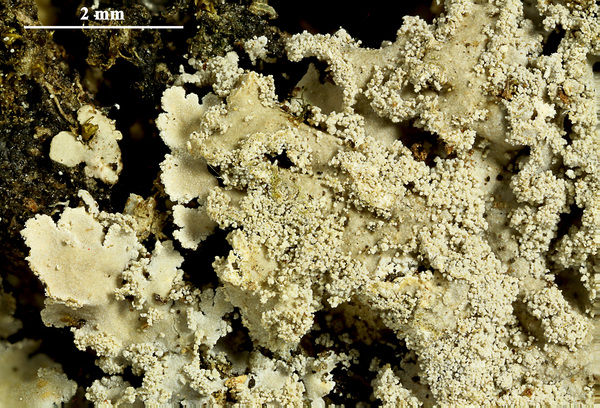
Felix Schumm - CC BY.SA 4.0
[13157], Vietnam, Nordvietnam, Hué, Kaiserpalast. Leg. F. Schumm, 26.04.2007, det. A. Aptroot 2009
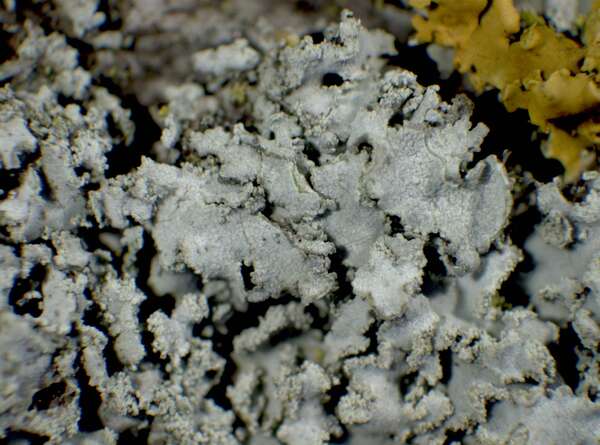
P.L. Nimis; Owner: Department of Life Sciences, University of Trieste
Herbarium: TSB (35569)
2002/01/21
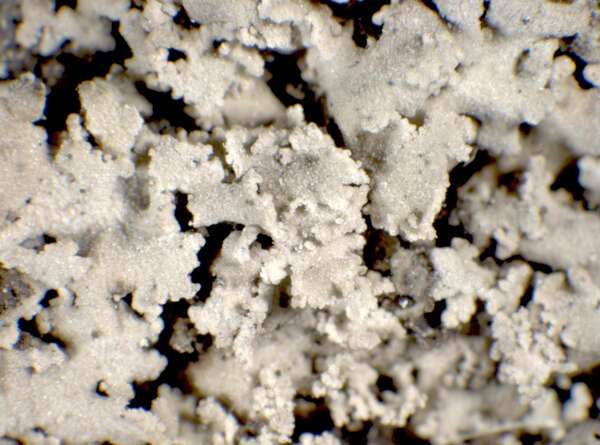
P.L. Nimis; Owner: Department of Life Sciences, University of Trieste
Herbarium: TSB (3203)
2001/12/05
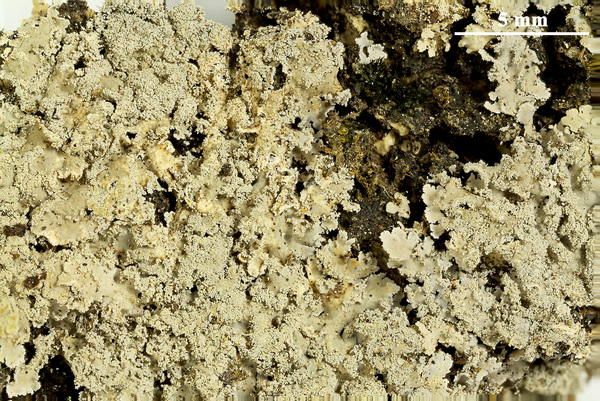
Felix Schumm - CC BY.SA 4.0
[13157], Vietnam, Nordvietnam, Hué, Kaiserpalast. Leg. F. Schumm, 26.04.2007, det. A. Aptroot 2009
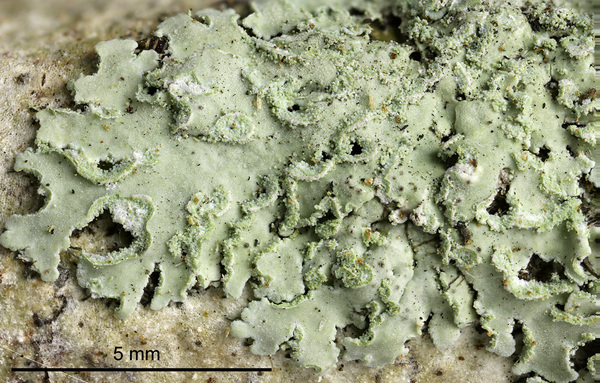
Felix Schumm - CC BY.SA 4.0
[14679], Seychellen, Mahe, W-Küste, Barbarons Estate, 4°43.214' S, 55°28.839' E, 17 m. Leg. F. Schumm & J.-P. Frahm, 11.10.2008, det. A. Aptroot, 2008
Growth form: Foliose, narrow lobed
Photobiont: green algae other than Trentepohlia
Reproductive strategy: mainly asexual, by soredia, or soredia-like structures (e.g. blastidia)
On otherwise dry surfaces with short periods of water seepage after rain
Commonnes-rarity: (info)
Alpine belt: absent
Subalpine belt: absent
Montane belt: absent
Dry submediterranean belt: very rare
Humid submediterranean belt: rare
Padanian area: absent
pH of the substrata:
| 1 | 2 | 3 | 4 | 5 |
Solar irradiation:
| 1 | 2 | 3 | 4 | 5 |
Aridity:
| 1 | 2 | 3 | 4 | 5 |
Eutrophication:
| 1 | 2 | 3 | 4 | 5 |
Poleotolerance:
| 0 | 1 | 2 | 3 |
Altitudinal distribution:
| 1 | 2 | 3 | 4 | 5 | 6 |
Rarity
absent
extremely rare
very rare
rare
rather rare
rather common
common
very common
extremely common
Loading data...
Occurrence data
Predictive map

Felix Schumm - CC BY.SA 4.0
[13157], Vietnam, Nordvietnam, Hué, Kaiserpalast. Leg. F. Schumm, 26.04.2007, det. A. Aptroot 2009

P.L. Nimis; Owner: Department of Life Sciences, University of Trieste
Herbarium: TSB (35569)
2002/01/21

P.L. Nimis; Owner: Department of Life Sciences, University of Trieste
Herbarium: TSB (3203)
2001/12/05

Felix Schumm - CC BY.SA 4.0
[13157], Vietnam, Nordvietnam, Hué, Kaiserpalast. Leg. F. Schumm, 26.04.2007, det. A. Aptroot 2009



